(continued from
previous page)
Although the campgrounds and screened shelters at Brazos Bend
are heavily used throughout the year by guests who stay
overnight for up to two weeks, the majority of visitors come
into the park for just one day.
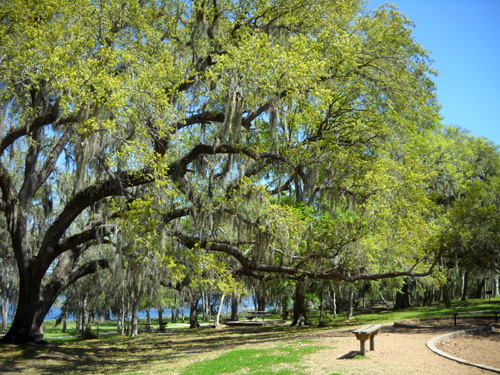
Above and below: Spanish moss hangs
from huge live oak trees
in the 40-Acre Lake picnic area and
playground.
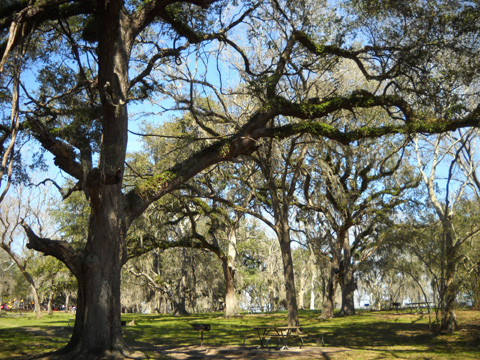
In this entry I'll describe camping options and other day-use
facilities than those I covered in the last entry.
Facilities like picnic areas, restrooms, the group dining hall,
park headquarters, the nature center, and George Observatory are
also used by overnight guests, of course.
I'll conclude with a section debating whether all these
activities and accommodations are a conflict of interest,
considering Brazos Bend is also a wildlife preserve. How does
park staff balance all this?
PICNIC AREAS
The park has three large picnic areas with numerous
tables and grills. I highlighted their locations in yellow on this map of the park facilities (click this
link for a larger map you can
read):
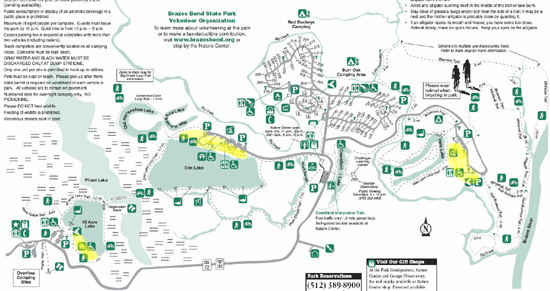
All three picnic areas have bathrooms and parking for several
hundred people who want to use the tables and/or walk on the
trails around 40-Acre, Elm, and Hale Lakes.
Two of the picnic areas have nice children's playgrounds -- 40-Acre
Lake and Hale Lake. There is a
third playground near the screened shelters and RV campground
loops for overnight
campers but day-use visitors often sneak into it, too:
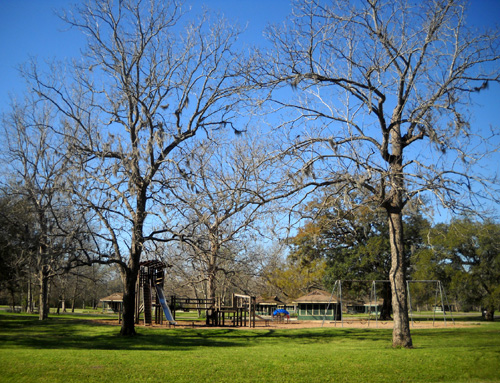
The Elm Lake and Hale Lake picnic areas each have a large
covered picnic pavilion that can be reserved for a
fee. Each group pavilion has
electricity, water, a large BBQ grill, and picnic tables that
will accommodate about 75 people.
DINING HALL
A large enclosed dining hall that seats about 100 people is
located between the screened room loop and primitive campsites:
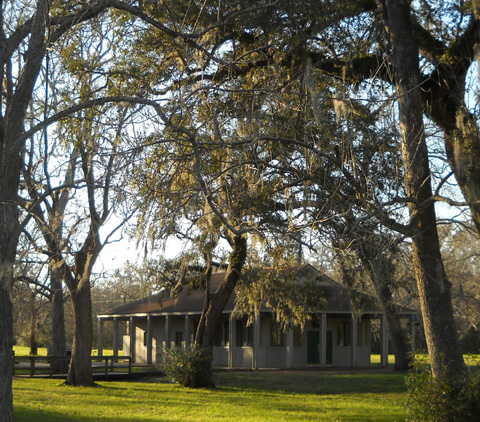
It can be
rented for either overnight or
day use. It has electricity and water, a full kitchen,
restroom, air
conditioning/heat, ceiling fans, tables, chairs, and BBQ pit.
Park staff also use it for meetings, luncheons, and interpretive
programs that are too large to be held in the nature center.
OVERNIGHT ACCOMMODATIONS
Unlike some Texas state parks,
Brazos Bend does not have a lodge or fully enclosed cabins for
guests. It does have a nice diversity of camping options for folks with and
without tents or RVs.
Reservations can be made for up to two
weeks at a time and may be extended if sites are available. Most
sites can be reserved -- not specific sites, just types of
sites. Upon arrival, however, guests may request a certain site
and get it if it is available. Overflow sites are first-come, first-served.
This section of the park map shows the two big campground loops,
smaller screened room loop, and primitive camping area (latter
is highlighted in
yellow):
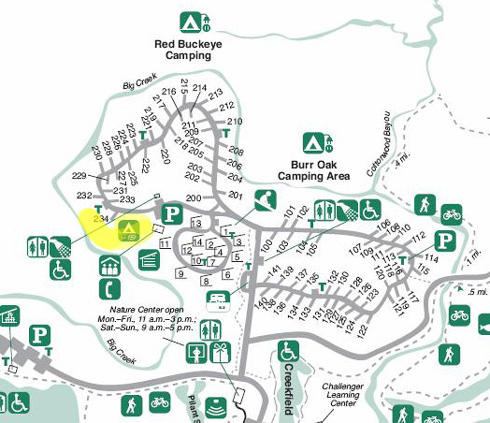
The overflow area, group camping sites, and equestrian
campground are located in other areas of the park.
Word of warning: weekends are usually booked up far in
advance, even in the winter, for the screened shelters,
RV loops, equestrian campground, and primitive campsites.
If you run into that problem, ask about staying in the overflow
area or remote equestrian campground. Those usually fill last. It's much easier to get a
screened room or campground site with little advance notice on
weekdays, except for Spring Break in March when the entire park
is packed. The only reason Jim and I got to stay that week was
our status as volunteer campground hosts.
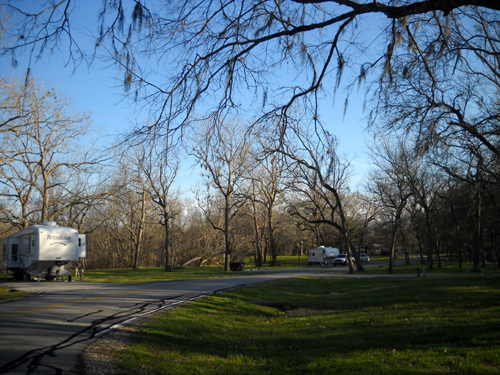
200-loop when it's not packed
Note that applicable entry fees ($5 per person age 13 and up,
per day) are charged in addition to site fees unless visitors
have a Texas state park pass. The passes are a bargain for
individuals, couples, and families who use the state parks
several times a year, even if it's only for day use. They're a
tremendous value for folks like us who stay overnight in the
parks for several weeks or months each year!
Here are your overnight options:
SCREENED ROOMS
There are fourteen handsome screened shelters that sport the
park's ubiquitous alligator motif:
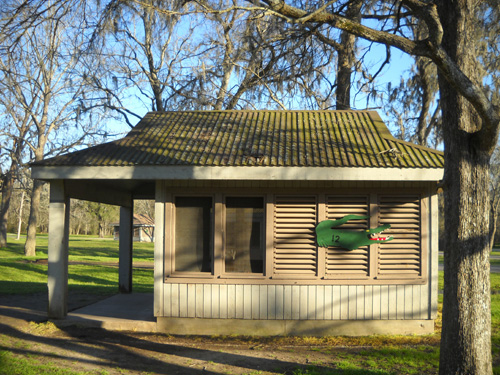
They are arranged in a large grassy area (below) near the
campgrounds, a restroom with showers, and a large dining hall/conference center that groups
can rent.
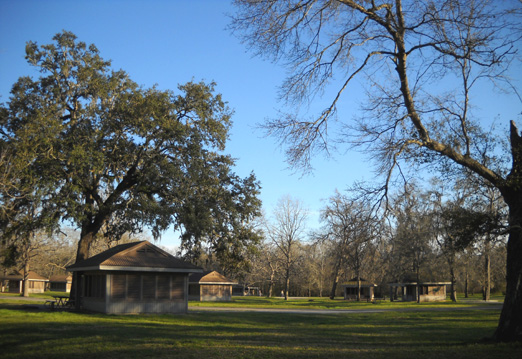
The shelters currently cost $25/night. They aren't heated and
don't have any utilities but they provide shade, a large grassy
yard, and a dry place
when it's raining. Some folks sleep inside their shelter on a
cot or air mattress/sleeping bag. Others set up tents in the
grass outside or park an RV in the driveway and use the shelter for dining and socializing.
There are plans to enclose one of the shelters this year so it
can be heated, cooled, and locked with a key. Check this fees
link on the park website re:
reserving any of the shelters.
RV SITES
There are two campground loops, designated "100" and "200," with
a total of 73 sites that are large enough for most RVs. Folks
with tents also reserve them, including metro-area Boy, Girl,
and Cub Scout groups that
may set up several tents at each site. Our 36-foot 5th-wheel
would fit into almost any of these sites with room to spare
-- a luxury for a public park.
We stayed in two sites in the 100-loop this month -- the
first site we rented for six days, and one of the campground host
sites for the last three weeks:
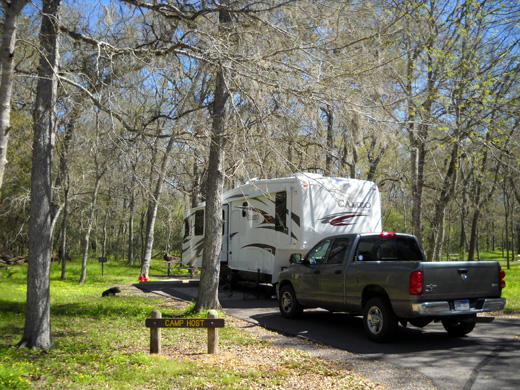
Our spacious host site
When host sites are vacant, the park
sometimes rents them out to visitors who want a sewer and are
willing to pay an extra $5/day for it. Host sites can't be
reserved ahead of time, however.
Guest sites have water and 30-amp electricity but no
sewer connection; there is a dump station near the
entrance to the 100-loop. These sites cost $20/night whether
you're sleeping in a tent or a big Class A motorhome.
Brazos Bend doesn't have a weekly rate in
the off-season because there is no off-season this close
to the Gulf! It's a very popular park and doesn't need that
incentive to draw visitors.
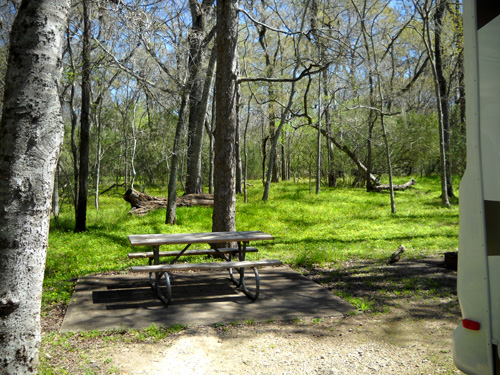
Our woodsy "back yard"
Both campground loops have restrooms with showers. Those are
also scheduled to be upgraded sometime in the next year.
There is a small laundry room for campers to use (not just
campground hosts, as in some parks) in the rear of the 200-loop
restroom. Most of the time we were there, however, the two
washers and two dryers were not working properly.
Both campground loops are very attractive. The 100-loop has more
shade and protection from wind; the "yards" tend to be
smaller but still afford some privacy. The 200-loop (below) has more
open, grassy areas to set up tents and for kids to run around
but tends to be more windy.
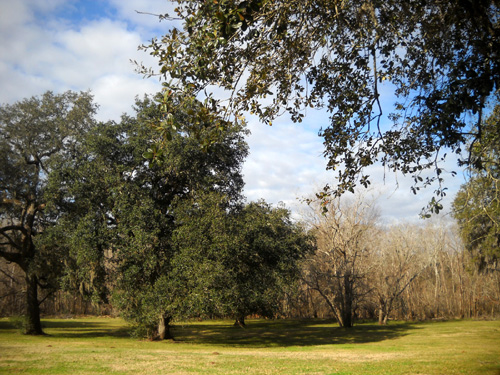
Although our Verizon signal is weak in the campground, we are
able to get online OK. WiFi is also available at the park
headquarters and nature center. Our TV reception is excellent
with only our camper antenna; we have clear reception of all the
major networks and PBS.
So far, this is my favorite Texas state park campground --
and park, too.
Brazos Bend is a good little ways from the stores, laundromats, YMCAs, and restaurants we prefer to use but we
could find everything we wanted in terms of goods and services
in Sugar Land and Missouri City on the south side of metro
Houston. Since they are 20-25 miles one way we limited our trips
"to town" to a couple times a week.
PRIMITIVE CAMPING SITES
Fourteen primitive sites situated around a large grassy field
between the 200-loop and the screened room loop fill up quickly
on weekends. Vehicles cannot park right next to these sites. All
camping equipment must be carried a little ways from two small
parking areas. Each site has a picnic table and fire ring. A
kids' playground and restrooms with showers are located nearby.
OVERFLOW CAMPING AREA
This loop near the park entrance/headquarters has one host site
with hookups and seventeen rather small guest sites. The closest
restrooms are in the HQ building.
Several of the sites have water, electricity, grills, and fire
rings ($15/night) and are suitable for RVs.
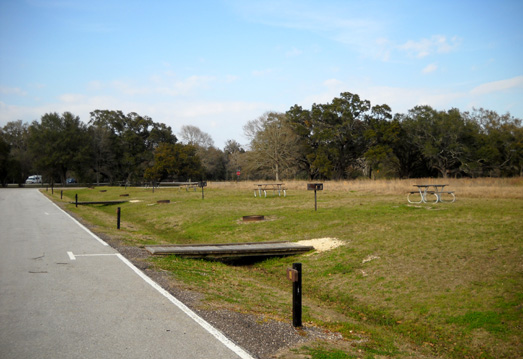
The remainder
(shown above) are primitive sites with picnic tables, grills, and fire rings but no hookups,
for $8/night.
Vehicles park in the paved
parking lot next to each site, so equipment doesn't have
to be carried as far as it does in the primitive campground near
the 200-loop. Tents can be set up in the grass on
the slope above the parking lot. Few people used these sites
during our stay -- except Spring Break week and the two bookend
weekends, when they were full.
PRIMITIVE EQUESTRIAN CAMPGROUND
Fondly referred to as "EQ" by park staff, this remote campground is located
inside the far
northeastern corner of the park and must be accessed via ten
miles of roadway
outside the park. Two horse trails allow access to the
other park trails by foot, bike, or hoof but motorized vehicles
other than official park ATVs and trucks can't use them. It's a
good three miles on those trails to the nature center and more
to the most popular lakes.
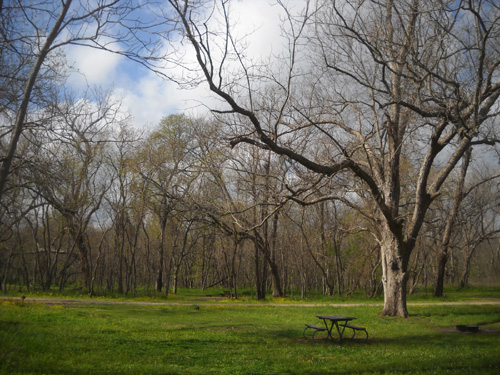
This is the only campground for folks with horses, however. And
some non-equestrian campers love the campground because
of its seclusion.
There are twenty shaded sites in a nice pecan grove. The
campground is located at the trailheads for eight miles of the
multi-use trails that equestrians may use. There are no water or
electric hookups at these sites, or shower facilities nearby.
There is water for horses and a portable toilet for humans. The
cost is $12/night.
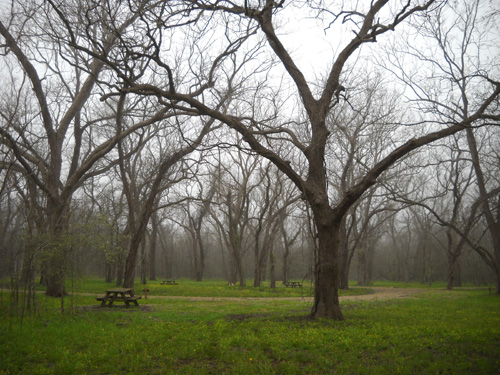
Jim, Ben (another campground host, L. in photo below), and I drove two
four-wheel drive Gators out several park trails to the
equestrian campground one very foggy morning soon after we began
our hosting job so we could put up some newly-painted signs:
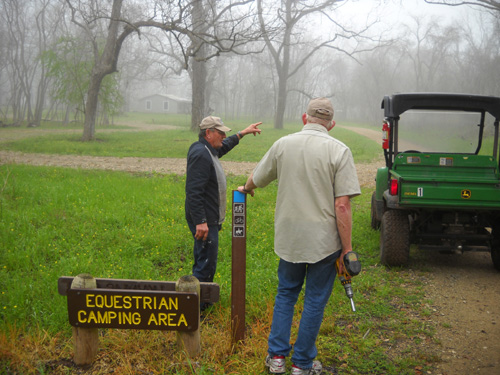
That afternoon I went back out on Jim's mountain bike to the campground to see it when the sun was out --
it looked more inviting then!
A few families without horses have used the equestrian
campground this month when the other campgrounds were full. We
haven't seen any horses yet; the trails have been too wet
most of the month for
the backcountry horse trails to be open to the public.
GROUP CAMPGROUNDS
There are two separate group campgrounds near Hale Lake that may be reserved
only by sponsored non-profit youth groups. One costs $25/night
for up to sixteen people, including the adults. The other is
$40/night for up to thirty-two people. These sites were busy
with Scout, church, and other groups during Spring Break and
each weekend we've been here, but empty during the week.
CONFLICT OF INTEREST?
Allowing recreational activities in a nature preserve creates
all kinds of challenges to park staff who have to balance what
can be conflicting demands between protection of the plants and
wildlife vs. allowing visitors to experience the wonders of
their surroundings.
The more people who come to the park, hopefully the more
advocates there will be to preserve it for future generations.
That's a Good Thing.
You can probably guess what some of the Bad Things are.
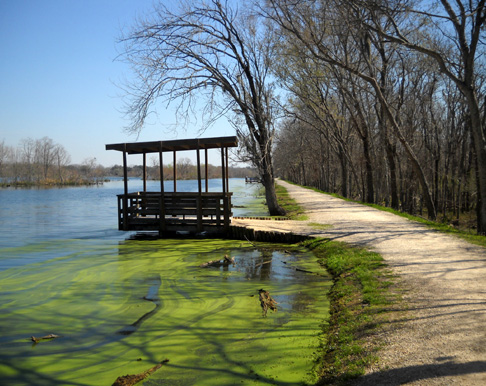
Fishing/picnicking pier along Elm Lake
I'm surprised there aren't more rules and regulations at Brazos
Bend than there
are. For example, pets are allowed on a leash everywhere except in
buildings. Every time I see a little yappy-dog walk within a
couple feet of a ten-foot alligator I think "Gator Bait" but
very few dogs (and no curious children!) have ever been harmed
by alligators at Brazos Bend.
One firm rule is that dogs and people, including fishermen,
aren't allowed to wade or swim in any of the bodies of water in the
park because of the alligators. Although the 'gators usually stay
pretty close to water, they've been spotted farther inland in the forests,
prairie areas, and campgrounds. We saw a five-foot alligator
strolling over the lawn near the
nature center one day, apparently traveling between two lakes
half a mile apart.
Spring is mating season and the males are on the move! It was
cool to hear them bellowing occasionally.
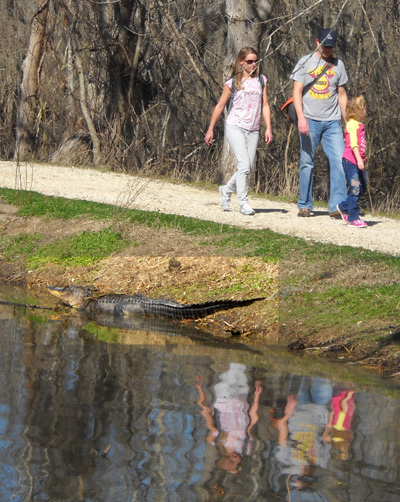
These folks were oblivious to the 'gator (I
highlighted him) in the water
below the trail until another visitor
pointed it out to them.
It was hard for Cody to not be able to jump into the lakes,
creeks, and swamps -- he's a Lab, after all. But we didn't allow
him in at all.
I kept him on his leash 99% of the time here, too, in case we
unexpectedly ran into a 'gator. He pretty much ignored them,
even the great big ones right along the trails.
The only
time he showed any interest in the critters was a few times when
younger ones got scared and quickly returned to the water. If
any critter runs, his instinct is to chase it briefly.
Fortunately, he obeys the command, "Leave it!"
When alligators were already lying in the grass next to a trail they usually just stayed there, not even batting an
eyelid when dogs and people passed a few feet away. Although
some keep their eyes open, many keep them closed and have that
unique "grin" on their snout:
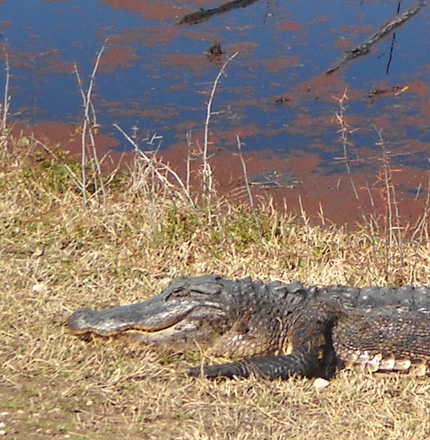
One big, happy boy!
That made me smile, too!
I think some of the 'gators must thrive on the attention they
receive! There are plenty of islands out in the lakes and swamps
and some very remote areas of the park that are "off the beaten
path" where they could live in total seclusion from civilization
if they wanted peace and quiet, yet many of them live around
heavily-visited 40-Acre and Elm Lakes and the spillway that
connects them.
Feeding and teasing the alligators is a big no-no but I saw
folks (even adults, to my dismay) doing it several times. All we
volunteers could do when we saw folks misbehaving badly was 1)
as diplomatically as possible, explain how the behavior adversely affects the wildlife or
other visitors, 2) warn them about potential fines, and 3) report
anything really egregious to a ranger.
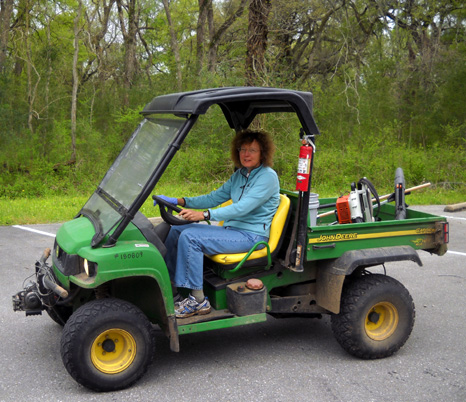
I had fun driving the ATVs around the park
to pick up trash and place signs
we'd painted! Ironically, one brand
is called a Gator.
Some ignorant people also throw trash in the lakes and wetlands.
Park staff and volunteers (like us campground hosts!) are kept
busy with litter control. It frustrated me that I couldn't fish
trash out of the water when it was beyond my reach but there was
no way I was going to wade out and get it! On a daily basis
volunteers pick up what trash they can reach in the campgrounds,
on trails, along the roads, etc. but rangers have to
periodically get in boats to retrieve trash in the water.
Ironically, the largest problem with litter was in the three
large picnic areas -- where there are plenty of trash
bins! There wasn't much litter on any of the trails.
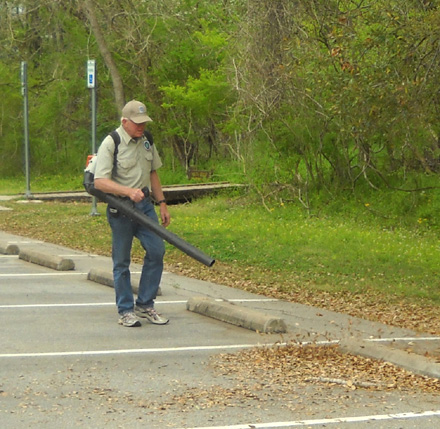
Jim tidies up a parking area at Hale Lake
with a leaf blower.
It's a shame people don't have more pride in their surroundings
and assume more personal responsibility. I just don't understand
how folks can trash such a beautiful, wild place (or anywhere
else, for that matter).
This park does an excellent job trying to better educate
its visitors with numerous exhibits and signs along the roads
and trails, beautiful colored maps with explanations, a large nature center, lots of free interpretive
programs, wildlife discovery programs for school and youth
groups, and a large, active corps of volunteers who are
available to answer questions and keep the place clean and
inviting.
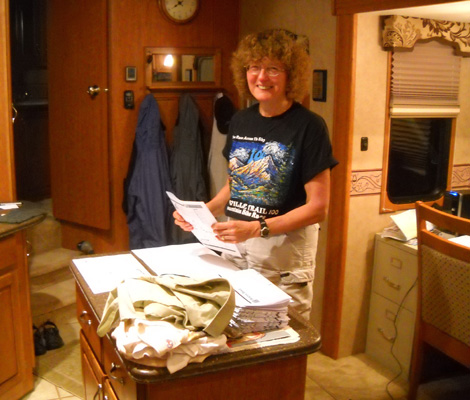
One of my jobs was folding maps for
visitors, a job I could do in the camper at night.
Hopefully those efforts will continue to instill the value of
keeping wild places natural, yet also available for recreational
purposes.
FURTHER INFORMATION AND RESERVATIONS
Check the park
website
for current information and procedures. The entire state
park system is due for a computer makeover later this spring,
with its own totally new reservation system. Once the inevitable
kinks are worked out, it should be easier to reserve sites and
it will eliminate the current reservation fee that is charged by Reserve
America.
Next entry:
heading to Georgia for Jim's next race
Happy trails,
Sue
"Runtrails & Company" - Sue Norwood, Jim O'Neil,
and Cody the Ultra Lab
Previous
Next
© 2010 Sue Norwood and Jim O'Neil